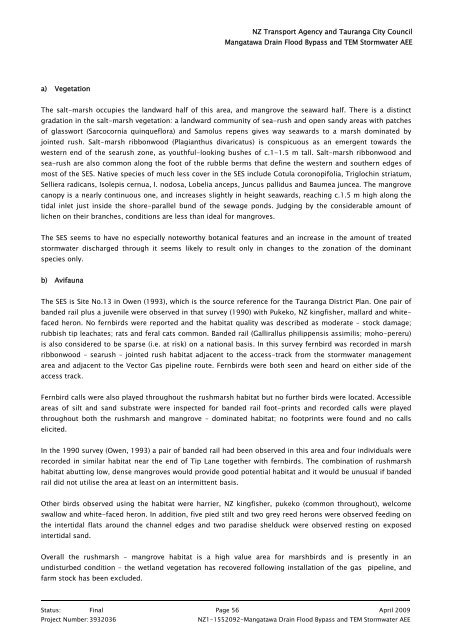2. Mangatawa catchment consents for earthworks, storm water ...
2. Mangatawa catchment consents for earthworks, storm water ...
2. Mangatawa catchment consents for earthworks, storm water ...
- No tags were found...
You also want an ePaper? Increase the reach of your titles
YUMPU automatically turns print PDFs into web optimized ePapers that Google loves.
NZ Transport Agency and Tauranga City Council<br />
<strong>Mangatawa</strong> Drain Flood Bypass and TEM Storm<strong>water</strong> AEE<br />
a) Vegetation<br />
The salt-marsh occupies the landward half of this area, and mangrove the seaward half. There is a distinct<br />
gradation in the salt-marsh vegetation: a landward community of sea-rush and open sandy areas with patches<br />
of glasswort (Sarcocornia quinqueflora) and Samolus repens gives way seawards to a marsh dominated by<br />
jointed rush. Salt-marsh ribbonwood (Plagianthus divaricatus) is conspicuous as an emergent towards the<br />
western end of the searush zone, as youthful-looking bushes of c.1-1.5 m tall. Salt-marsh ribbonwood and<br />
sea-rush are also common along the foot of the rubble berms that define the western and southern edges of<br />
most of the SES. Native species of much less cover in the SES include Cotula coronopifolia, Triglochin striatum,<br />
Selliera radicans, Isolepis cernua, I. nodosa, Lobelia anceps, Juncus pallidus and Baumea juncea. The mangrove<br />
canopy is a nearly continuous one, and increases slightly in height seawards, reaching c.1.5 m high along the<br />
tidal inlet just inside the shore-parallel bund of the sewage ponds. Judging by the considerable amount of<br />
lichen on their branches, conditions are less than ideal <strong>for</strong> mangroves.<br />
The SES seems to have no especially noteworthy botanical features and an increase in the amount of treated<br />
<strong>storm</strong><strong>water</strong> discharged through it seems likely to result only in changes to the zonation of the dominant<br />
species only.<br />
b) Avifauna<br />
The SES is Site No.13 in Owen (1993), which is the source reference <strong>for</strong> the Tauranga District Plan. One pair of<br />
banded rail plus a juvenile were observed in that survey (1990) with Pukeko, NZ kingfisher, mallard and whitefaced<br />
heron. No fernbirds were reported and the habitat quality was described as moderate – stock damage;<br />
rubbish tip leachates; rats and feral cats common. Banded rail (Gallirallus philippensis assimilis; moho-pereru)<br />
is also considered to be sparse (i.e. at risk) on a national basis. In this survey fernbird was recorded in marsh<br />
ribbonwood – searush – jointed rush habitat adjacent to the access-track from the <strong>storm</strong><strong>water</strong> management<br />
area and adjacent to the Vector Gas pipeline route. Fernbirds were both seen and heard on either side of the<br />
access track.<br />
Fernbird calls were also played throughout the rushmarsh habitat but no further birds were located. Accessible<br />
areas of silt and sand substrate were inspected <strong>for</strong> banded rail foot-prints and recorded calls were played<br />
throughout both the rushmarsh and mangrove – dominated habitat; no footprints were found and no calls<br />
elicited.<br />
In the 1990 survey (Owen, 1993) a pair of banded rail had been observed in this area and four individuals were<br />
recorded in similar habitat near the end of Tip Lane together with fernbirds. The combination of rushmarsh<br />
habitat abutting low, dense mangroves would provide good potential habitat and it would be unusual if banded<br />
rail did not utilise the area at least on an intermittent basis.<br />
Other birds observed using the habitat were harrier, NZ kingfisher, pukeko (common throughout), welcome<br />
swallow and white-faced heron. In addition, five pied stilt and two grey reed herons were observed feeding on<br />
the intertidal flats around the channel edges and two paradise shelduck were observed resting on exposed<br />
intertidal sand.<br />
Overall the rushmarsh – mangrove habitat is a high value area <strong>for</strong> marshbirds and is presently in an<br />
undisturbed condition – the wetland vegetation has recovered following installation of the gas pipeline, and<br />
farm stock has been excluded.<br />
Status: Final Page 56 April 2009<br />
Project Number: 3932036<br />
NZ1-1552092-<strong>Mangatawa</strong> Drain Flood Bypass and TEM Storm<strong>water</strong> AEE
















